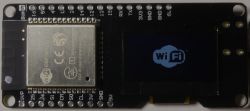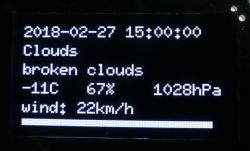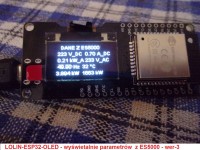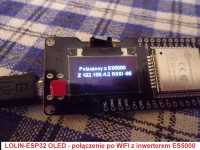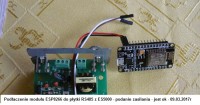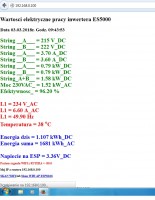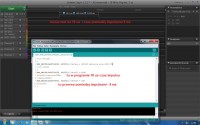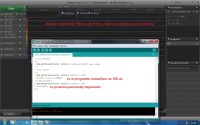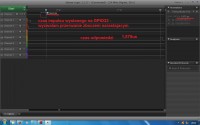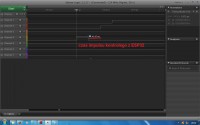Soon, on elektroda.pl, a WiFi module will appear with an ESP32 board and an OLED SSD1306 display. The ESP32 capabilities and the integration with Arduino are described here: ESP32 + Arduino . The English-language description of the integration is available here: ESP32 & Arduino on Windows .
The SSD1306 display works on the I2C bus at the address 0x3C. SCL is connected to pin 4, SDA to I / O 5 - ESP32. On the board we find a USB UART converter, a 3.3V stabilizer and ESP32 terminals led to the edges of the board. The monochrome OLED display provides a very good contrast and a pleasant image appearance.
One of the libraries, eg U8g2, can be used to operate the display. After selecting Sketch-> Attach Library-> Manage Libraries, we can add or update U8g2. The configuration of the built-in display in U8g2 is as follows:
U8G2_SSD1306_128X64_NONAME_F_SW_I2C u8g2 (U8G2_R0, / * clock = * / 4, / * data = * / 5, / * reset = * / U8X8_PIN_NONE);
Set the board as Wemos ESP32: Tools-> WEMOS LOLIN32
ESP32 has more RAM than ESP8266 or ATmega328 and we can more conveniently process data in JSON format provided in the API of many systems. For example, the weather forecasts http://openweathermap.org/api and https://www.wunderground.com/weather/api or air quality data https://airly.eu/pl/api/ are available as JSON.
Much of this data is available online for free, just register an account and receive your personal key.
In the case of openweathermap http://openweathermap.org/price, after creating an account, we receive our key, after checking what ID has our city http://bulk.openweathermap.org/sample/city.list.json.gz (e.g. for Warsaw 7531926 ) we can send inquiries and present the weather forecast on the display.
To conveniently process JSON data, add the ArduinoJson library to Arduino by searching for it in Sketch-> Attach library-> Manage libraries.
We get the weather forecast for the following hours in a fairly simple way:

Below is an example of a simple code that you can adapt both to display the current weather forecast, as well as to virtually any data published by JSON. Instead of descriptions, you can enter a graphical representation of the weather forecast: https://openweathermap.org/weather-conditions
What ideas do you have for using a miniature WiFi module with ESP32 and a 128x64 OLED display?

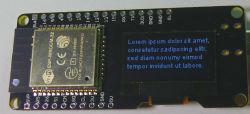
The SSD1306 display works on the I2C bus at the address 0x3C. SCL is connected to pin 4, SDA to I / O 5 - ESP32. On the board we find a USB UART converter, a 3.3V stabilizer and ESP32 terminals led to the edges of the board. The monochrome OLED display provides a very good contrast and a pleasant image appearance.
One of the libraries, eg U8g2, can be used to operate the display. After selecting Sketch-> Attach Library-> Manage Libraries, we can add or update U8g2. The configuration of the built-in display in U8g2 is as follows:
U8G2_SSD1306_128X64_NONAME_F_SW_I2C u8g2 (U8G2_R0, / * clock = * / 4, / * data = * / 5, / * reset = * / U8X8_PIN_NONE);
Set the board as Wemos ESP32: Tools-> WEMOS LOLIN32
ESP32 has more RAM than ESP8266 or ATmega328 and we can more conveniently process data in JSON format provided in the API of many systems. For example, the weather forecasts http://openweathermap.org/api and https://www.wunderground.com/weather/api or air quality data https://airly.eu/pl/api/ are available as JSON.
Much of this data is available online for free, just register an account and receive your personal key.
In the case of openweathermap http://openweathermap.org/price, after creating an account, we receive our key, after checking what ID has our city http://bulk.openweathermap.org/sample/city.list.json.gz (e.g. for Warsaw 7531926 ) we can send inquiries and present the weather forecast on the display.
To conveniently process JSON data, add the ArduinoJson library to Arduino by searching for it in Sketch-> Attach library-> Manage libraries.
We get the weather forecast for the following hours in a fairly simple way:

Below is an example of a simple code that you can adapt both to display the current weather forecast, as well as to virtually any data published by JSON. Instead of descriptions, you can enter a graphical representation of the weather forecast: https://openweathermap.org/weather-conditions
Code: C / C++
What ideas do you have for using a miniature WiFi module with ESP32 and a 128x64 OLED display?


Cool? Ranking DIY






